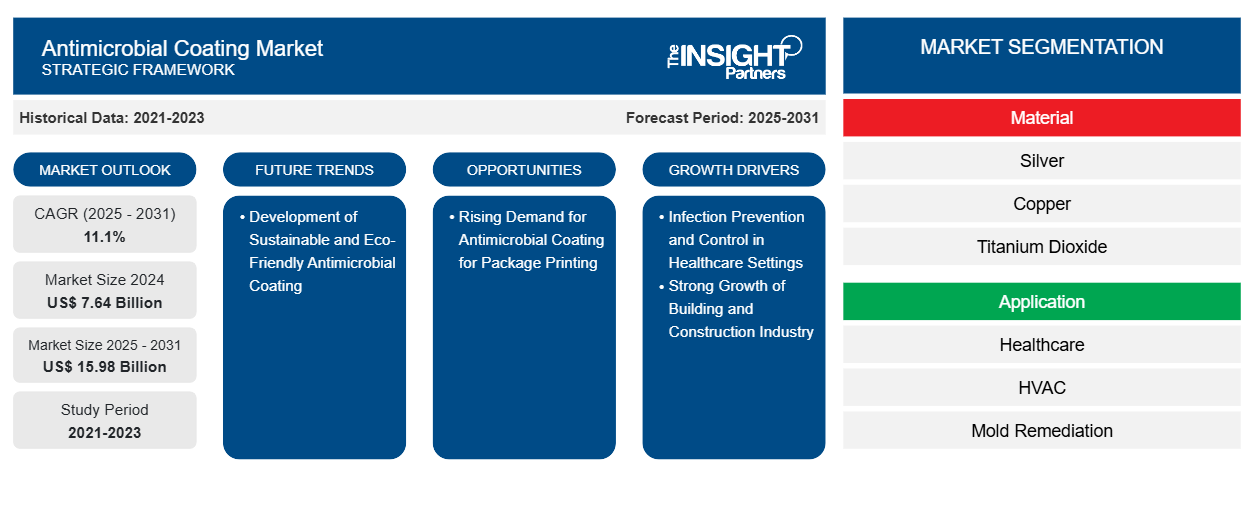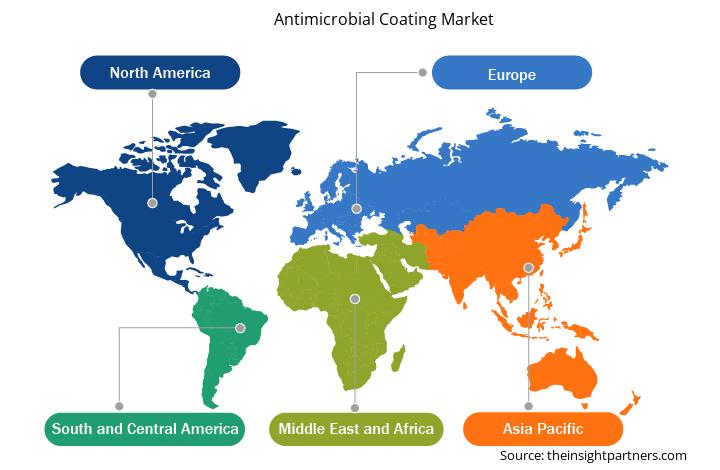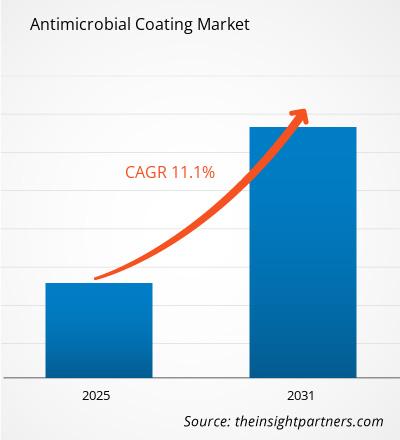من المتوقع أن يصل حجم سوق الطلاءات المضادة للميكروبات إلى 15.98 مليار دولار أمريكي بحلول عام 2031، مقارنةً بـ 7.64 مليار دولار أمريكي في عام 2024. ومن المتوقع أن يسجل السوق معدل نمو سنوي مركب قدره 11.1% خلال الفترة 2025-2031. ومن المرجح أن يُحدث تطوير الطلاءات المضادة للميكروبات المستدامة والصديقة للبيئة اتجاهات جديدة في السوق خلال الفترة المتوقعة.
تحليل سوق الطلاء المضاد للميكروبات
تستثمر حكومات دول مختلفة في توسيع وتحسين المستشفيات، مما يُعزز التركيز على تدابير مكافحة العدوى. ونظرًا لارتفاع معدلات العدوى المرتبطة بالرعاية الصحية، تتبنى المؤسسات الطبية طلاءً مضادًا للميكروبات للأجهزة الطبية ومعدات المستشفيات والأسطح كثيرة اللمس، مثل درابزين الأسرّة ومقابض الأبواب. علاوة على ذلك، يشهد قطاع الإنشاءات في المكسيك نموًا قويًا بفضل ازدياد مشاريع البنية التحتية، بما في ذلك المشاريع السكنية والتجارية. ومن المتوقع أن يُسهم الطلب المتزايد على الطلاء المضاد للميكروبات لطباعة العبوات في توفير فرص ربحية أكبر لنمو سوق الطلاء المضاد للميكروبات العالمي خلال فترة التوقعات.
نظرة عامة على سوق الطلاء المضاد للميكروبات
يتزايد الطلب على الطلاءات المضادة للميكروبات نظرًا لتزايد حالات العدوى المرتبطة بالرعاية الصحية. ومن المتوقع أن يشهد قطاع الرعاية الصحية تحولًا هائلاً في السنوات القادمة نتيجةً لعوامل مختلفة، مثل التوسع الحضري السريع، وارتفاع حالات الأمراض المعدية، وتغير نمط حياة المستهلك. وقد ازداد الطلب على الطلاءات المضادة للميكروبات في مرافق الرعاية الصحية لتعقيم الأجهزة الطبية. ومع ذلك، فقد وجدت هذه الطلاءات تطبيقات في مجالات التهوية والتكييف الداخلي، بالإضافة إلى الصناعات الطبية، والبناء والتشييد، والأغذية والمشروبات، ومعالجة العفن، والتغليف. ومن خلال الدراسات البحثية الفعالة وإجراءات التطوير، يقدم الباحثون والعلماء منتجات مبتكرة تتعلق بالطلاءات المضادة للميكروبات. ويرتبط أحدث الابتكارات بتطوير طلاءات مضادة للميكروبات متعددة الوظائف، ومنخفضة التكلفة، ومتينة. ومن المتوقع أن يوفر هذا فرص نمو واسعة للشركات الرئيسية العاملة في هذا السوق خلال فترة التوقعات.
قم بتخصيص هذا التقرير ليناسب متطلباتك
ستحصل على تخصيص لأي تقرير - مجانًا - بما في ذلك أجزاء من هذا التقرير، أو تحليل على مستوى الدولة، وحزمة بيانات Excel، بالإضافة إلى الاستفادة من العروض والخصومات الرائعة للشركات الناشئة والجامعات
سوق الطلاء المضاد للميكروبات: رؤى استراتيجية

-
احصل على أهم اتجاهات السوق الرئيسية لهذا التقرير.ستتضمن هذه العينة المجانية تحليل البيانات، بدءًا من اتجاهات السوق وحتى التقديرات والتوقعات.
محركات وفرص سوق الطلاء المضاد للميكروبات
الوقاية من العدوى ومكافحتها في مؤسسات الرعاية الصحية
يمكن أن تُسهم مرافق الرعاية الصحية في انتشار أنواع مُختلفة من العدوى، مما يُلحق الضرر بالعاملين الصحيين والمرضى والزوار. ووفقًا لمنظمة الصحة العالمية، من بين كل 100 مريض في مستشفيات الرعاية الحادة، يُصاب 7 مرضى في البلدان مرتفعة الدخل و15 مريضًا في البلدان منخفضة ومتوسطة الدخل على التوالي بعدوى واحدة على الأقل مُرتبطة بالرعاية الصحية (HAI) أثناء إقامتهم في المستشفى. إضافةً إلى ذلك، تُسبب العدوى المُرتبطة بالرعاية الصحية، في المتوسط، وفاة واحد من كل عشرة مرضى مُصابين. ويُعتبر حديثو الولادة والمرضى في العناية المركزة أكثر عُرضةً للإصابة بالعدوى. ويُشير تقرير جديد صادر عن منظمة الصحة العالمية إلى أنه يُمكن الوقاية من 70% من هذه العدوى باتباع ممارسات نظافة اليدين الجيدة وغيرها من الممارسات الفعّالة من حيث التكلفة. ونتيجةً لذلك، أصبحت الوقاية من العدوى ومكافحتها جانبًا مهمًا من ممارسات الرعاية الصحية الحديثة. وقد خصصت العديد من البلدان جهةً مُختصةً للوقاية من العدوى ومكافحتها (IPC)، إلى جانب ميزانية مُخصصة لها ومنهجًا لتدريب العاملين الصحيين في الخطوط الأمامية. وبمساعدة هذه الميزانية، تُطوّر هيئات الرعاية الصحية إرشادات وطنية للوقاية من العدوى ومكافحتها، وبرنامجًا أو خطةً وطنيةً لمراقبة العدوى المُرتبطة بالرعاية الصحية، وتُرسّخ الالتزام بنظافة اليدين كمؤشر وطني رئيسي. تُظهر العديد من الدول حول العالم التزامًا قويًا وتقدمًا ملحوظًا في تكثيف الإجراءات الرامية إلى تحديد الحد الأدنى من المتطلبات والمكونات الأساسية لبرامج الوقاية من العدوى ومكافحتها. علاوة على ذلك، يتزايد الوعي بأهمية ممارسات النظافة والتعقيم. وتعتمد مرافق الرعاية الصحية تدابير متطورة لمنع انتشار مسببات الأمراض. توفر الطلاءات المضادة للميكروبات طبقة حماية مستمرة وسلبية ضد الكائنات الدقيقة الضارة. وتُدمج هذه الطلاءات بشكل متزايد في المعدات الطبية وتجهيزات الرعاية الصحية للوقاية من العدوى ومكافحتها. وبالتالي، فإن التركيز على الوقاية من العدوى ومكافحتها في مرافق الرعاية الصحية يُعزز نمو سوق الطلاءات المضادة للميكروبات.
ارتفاع الطلب على الطلاء المضاد للميكروبات لطباعة العبوات
تتضمن طباعة العبوات وضع الأحبار والطلاءات على مواد متنوعة، مثل الورق والكرتون والبلاستيك والمعادن. تُعدّ العبوات بمثابة لوحة إعلانية لعرض معلومات المنتجات والعلامات التجارية، بالإضافة إلى كونها طبقة حماية أساسية تحمي المنتجات من الرطوبة والأكسجين والروائح والبقع والميكروبات المُهلكة للمواد، وغيرها من المخاطر البيئية. أصبحت الطلاءات المضادة للميكروبات ضرورة للعلامات التجارية الرائدة التي تُركز بشكل متزايد على النظافة والرفاهية. تُحدث الطلاءات المضادة للميكروبات تغييرًا جذريًا في طريقة حماية العلامات التجارية لمنتجاتها وموادها من خلال استخدام تركيبات كيميائية متطورة مُصممة لمنع نمو الميكروبات. تحتوي هذه الطلاءات على عوامل فعالة، معروفة بخصائصها القوية المضادة للميكروبات. تزداد قيمة الطلاءات الحاجزة المضادة للميكروبات في الصناعات التي قد يُهدد فيها التلوث الميكروبي جودة المنتج أو سلامته. تمنع الطلاءات المضادة للميكروبات التلف عن طريق تثبيط نمو البكتيريا والعفن، مما يُطيل فترة نضارة المنتج في عبوات الطعام. في عبوات الرعاية الصحية، تُوفر هذه الطلاءات طبقة حماية إضافية، مما يضمن حماية المنتج. تساعد هذه الطلاءات المضادة للميكروبات العلامات التجارية على حماية جودة المنتج، وإطالة العمر الافتراضي، وبناء ثقة المستهلك في سوق يولي اهتمامًا متزايدًا للنظافة.
تقرير تحليل تجزئة سوق الطلاء المضاد للميكروبات
القطاعات الرئيسية التي ساهمت في اشتقاق تحليل سوق الطلاء المضاد للميكروبات هي المواد والتطبيق.
- حسب المادة، يُقسّم سوق الطلاء المضاد للميكروبات إلى الفضة والنحاس وثاني أكسيد التيتانيوم وغيرها. وقد استحوذت الفضة على الحصة الأكبر من السوق في عام ٢٠٢٤.
- من حيث التطبيق، يُصنف السوق إلى الرعاية الصحية، وأنظمة التدفئة والتهوية وتكييف الهواء، ومعالجة العفن، والبناء والتشييد، والأغذية والمشروبات، وغيرها. وقد استحوذ قطاع الرعاية الصحية على الحصة الأكبر من السوق في عام 2024.
تحليل حصة سوق الطلاء المضاد للميكروبات حسب المنطقة الجغرافية
ينقسم النطاق الجغرافي لتقرير سوق الطلاء المضاد للميكروبات إلى خمس مناطق: أمريكا الشمالية، وآسيا والمحيط الهادئ، وأوروبا، والشرق الأوسط وأفريقيا، وأمريكا الجنوبية والوسطى. ومن المتوقع أن يشهد سوق الطلاء المضاد للميكروبات في آسيا والمحيط الهادئ نموًا ملحوظًا خلال فترة التوقعات.
تُعدّ منطقة آسيا والمحيط الهادئ من أبرز أسواق الطلاء المضاد للميكروبات، مدفوعةً بمبادرات الصحة العامة المتواصلة، والنمو الصناعي، والابتكارات التكنولوجية في إنتاج وتطبيق الطلاء المضاد للميكروبات. وتتصدر دولٌ مثل الصين والهند واليابان سوق الطلاء المضاد للميكروبات في آسيا والمحيط الهادئ بفضل كثافتها السكانية، وتوسع بنيتها التحتية للرعاية الصحية، وازدياد الوعي بأهمية النظافة ومكافحة العدوى. إضافةً إلى ذلك، ساهمت المبادرات الحكومية التي تُشجع على ممارسات النظافة والتطهير في تعزيز اعتماد الطلاء المضاد للميكروبات. كما يُسهم قطاع الأغذية والمشروبات في المنطقة بشكلٍ كبير في زيادة الطلب، إذ يُستخدم الطلاء المضاد للميكروبات لضمان السلامة الميكروبية في عمليات التعبئة والتغليف والمعالجة.
يشهد قطاع البناء في منطقة آسيا والمحيط الهادئ نموًا سريعًا بفضل التوسع الحضري وتطوير البنية التحتية. وتستثمر دول مثل الصين والهند وإندونيسيا وفيتنام بكثافة في مشاريع البنية التحتية التجارية والسكنية والعامة. وتُعد هذه المشاريع أساسية لتحسين الاتصال، وتعزيز النمو الاقتصادي، وتحسين جودة الحياة بشكل عام. ونتيجةً لذلك، يزداد الطلب على الطلاء المضاد للميكروبات لدعم تخطيط وتنفيذ هذه المبادرات الحيوية في مجال البناء والبنية التحتية. وقد أدى التركيز المتزايد على جودة الهواء الداخلي والنظافة والسلامة إلى زيادة استخدام الطلاء المضاد للميكروبات في أنظمة التدفئة والتهوية وتكييف الهواء، والجدران، والأرضيات، والأسطح المعرضة للمس بكثرة. بالإضافة إلى ذلك، أدى الطلب على المباني الذكية والمستدامة إلى زيادة اعتماد الطلاء المضاد للميكروبات في مشاريع البناء الحديثة، مما ساهم في نمو السوق.
رؤى إقليمية حول سوق الطلاء المضاد للميكروبات
قام محللو شركة إنسايت بارتنرز بشرح شامل للاتجاهات والعوامل الإقليمية المؤثرة في سوق الطلاء المضاد للميكروبات خلال فترة التوقعات. ويناقش هذا القسم أيضًا قطاعات سوق الطلاء المضاد للميكروبات ومناطقه الجغرافية في أمريكا الشمالية، وأوروبا، وآسيا والمحيط الهادئ، والشرق الأوسط وأفريقيا، وأمريكا الجنوبية والوسطى.

- احصل على البيانات الإقليمية المحددة لسوق الطلاء المضاد للميكروبات
نطاق تقرير سوق الطلاء المضاد للميكروبات
| سمة التقرير | تفاصيل |
|---|---|
| حجم السوق في عام 2024 | 7.64 مليار دولار أمريكي |
| حجم السوق بحلول عام 2031 | 15.98 مليار دولار أمريكي |
| معدل النمو السنوي المركب العالمي (2025 - 2031) | 11.1% |
| البيانات التاريخية | 2021-2023 |
| فترة التنبؤ | 2025-2031 |
| القطاعات المغطاة |
حسب المادة
|
| المناطق والدول المغطاة |
أمريكا الشمالية
|
| قادة السوق وملفات تعريف الشركات الرئيسية |
|
كثافة اللاعبين في سوق الطلاء المضاد للميكروبات: فهم تأثيرها على ديناميكيات الأعمال
يشهد سوق الطلاءات المضادة للميكروبات نموًا سريعًا، مدفوعًا بتزايد طلب المستخدمين النهائيين نتيجةً لعوامل مثل تفضيلات المستهلكين المتطورة، والتقدم التكنولوجي، وزيادة الوعي بفوائد المنتج. ومع تزايد الطلب، تعمل الشركات على توسيع عروضها، والابتكار لتلبية احتياجات المستهلكين، والاستفادة من الاتجاهات الناشئة، مما يُعزز نمو السوق.
تشير كثافة اللاعبين في السوق إلى توزيع الشركات العاملة في سوق أو قطاع معين. وتشير إلى عدد المنافسين (اللاعبين في السوق) الموجودين في سوق معين نسبةً إلى حجمه أو قيمته السوقية الإجمالية.
الشركات الرئيسية العاملة في سوق الطلاء المضاد للميكروبات هي:
- شركة كوبرون
- شركة أليستاجين
- تقنيات فايبرلوك
- شركة شيروين ويليامز
- شركة بي بي جي للصناعات
- أكزو نوبل إن في
إخلاء المسؤولية : الشركات المذكورة أعلاه ليست مرتبة بأي ترتيب معين.

- احصل على نظرة عامة على أهم اللاعبين الرئيسيين في سوق الطلاء المضاد للميكروبات
أخبار سوق الطلاء المضاد للميكروبات والتطورات الأخيرة
يُقيّم سوق الطلاءات المضادة للميكروبات من خلال جمع بيانات نوعية وكمية بعد البحث الأولي والثانوي، والتي تشمل منشورات الشركات المهمة، وبيانات الجمعيات، وقواعد البيانات. وفيما يلي بعض التطورات الرئيسية في سوق الطلاءات المضادة للميكروبات:
- أعلنت شركة هيدرومر (OTC: HYDI)، الشركة المُصنِّعة لتقنيات الطلاء المُحبّة للماء والمقاومة للجلطات والمضادة للميكروبات للأجهزة الطبية، عن إطلاق هيدروثرومبكس، وهو إصدار من الجيل التالي من منتج الشركة القديم F200t، وهو طلاء مقاوم للجلطات معروف في هذا المجال بقدرته على الحدّ بشكل كبير من التصاق الصفائح الدموية وانقسام الخلايا، مما يُساعد في الوقاية من عودة تضيّق الأوعية الدموية. (المصدر: موقع شركة هيدرومر الإلكتروني، يونيو 2024)
- أعلنت شركة NEI Corporation عن إطلاق NANOMYTE AM-100EC، وهو طلاء جديد بسُمك ميكرون واحد، مُصمم لإضفاء خصائص سهلة التنظيف ومضادة للميكروبات على مجموعة متنوعة من الأسطح. يتميز الطلاء بقوة التصاق عالية بمجموعة واسعة من المواد الشائعة في التطبيقات عالية اللمس، بما في ذلك البلاستيك والمعادن والسيراميك. هذا يجعل AM-100EC الحل الأمثل للصناعات ذات متطلبات النظافة الصارمة، مثل الرعاية الصحية، وخدمات الطعام، والتعليم، والنقل العام. (المصدر: شركة NEI Corporation، بيان صحفي، يونيو 2024)
تغطية تقرير سوق الطلاء المضاد للميكروبات والنتائج المتوقعة
يقدم تقرير "حجم سوق الطلاء المضاد للميكروبات والتوقعات (2021-2031)" تحليلاً مفصلاً للسوق يغطي المجالات التالية:
- حجم سوق الطلاء المضاد للميكروبات وتوقعاته على المستويات العالمية والإقليمية والوطنية لجميع قطاعات السوق الرئيسية التي يغطيها النطاق
- اتجاهات سوق الطلاء المضاد للميكروبات، بالإضافة إلى ديناميكيات السوق مثل المحركات والقيود والفرص الرئيسية
- تحليل مفصل لقوى بورتر الخمس ونقاط القوة والضعف والفرص والتهديدات
- تحليل سوق الطلاء المضاد للميكروبات يغطي اتجاهات السوق الرئيسية والإطار العالمي والإقليمي والجهات الفاعلة الرئيسية واللوائح والتطورات الأخيرة في السوق
- تحليل المشهد الصناعي والمنافسة الذي يغطي تركيز السوق، وتحليل خريطة الحرارة، واللاعبين البارزين، والتطورات الأخيرة في سوق الطلاء المضاد للميكروبات
- ملفات تعريف الشركة التفصيلية
- التحليل التاريخي (سنتان)، سنة الأساس، التوقعات (7 سنوات) مع معدل النمو السنوي المركب
- تحليل PEST و SWOT
- حجم السوق والقيمة / الحجم - عالمي، إقليمي، بلد
- الصناعة والمنافسة
- مجموعة بيانات إكسل
التقارير الحديثة
تقارير ذات صلة
شهادات العملاء
سبب الشراء
- اتخاذ قرارات مدروسة
- فهم ديناميكيات السوق
- تحليل المنافسة
- رؤى العملاء
- توقعات السوق
- تخفيف المخاطر
- التخطيط الاستراتيجي
- مبررات الاستثمار
- تحديد الأسواق الناشئة
- تحسين استراتيجيات التسويق
- تعزيز الكفاءة التشغيلية
- مواكبة التوجهات التنظيمية






















 احصل على عينة مجانية ل - سوق الطلاء المضاد للميكروبات
احصل على عينة مجانية ل - سوق الطلاء المضاد للميكروبات